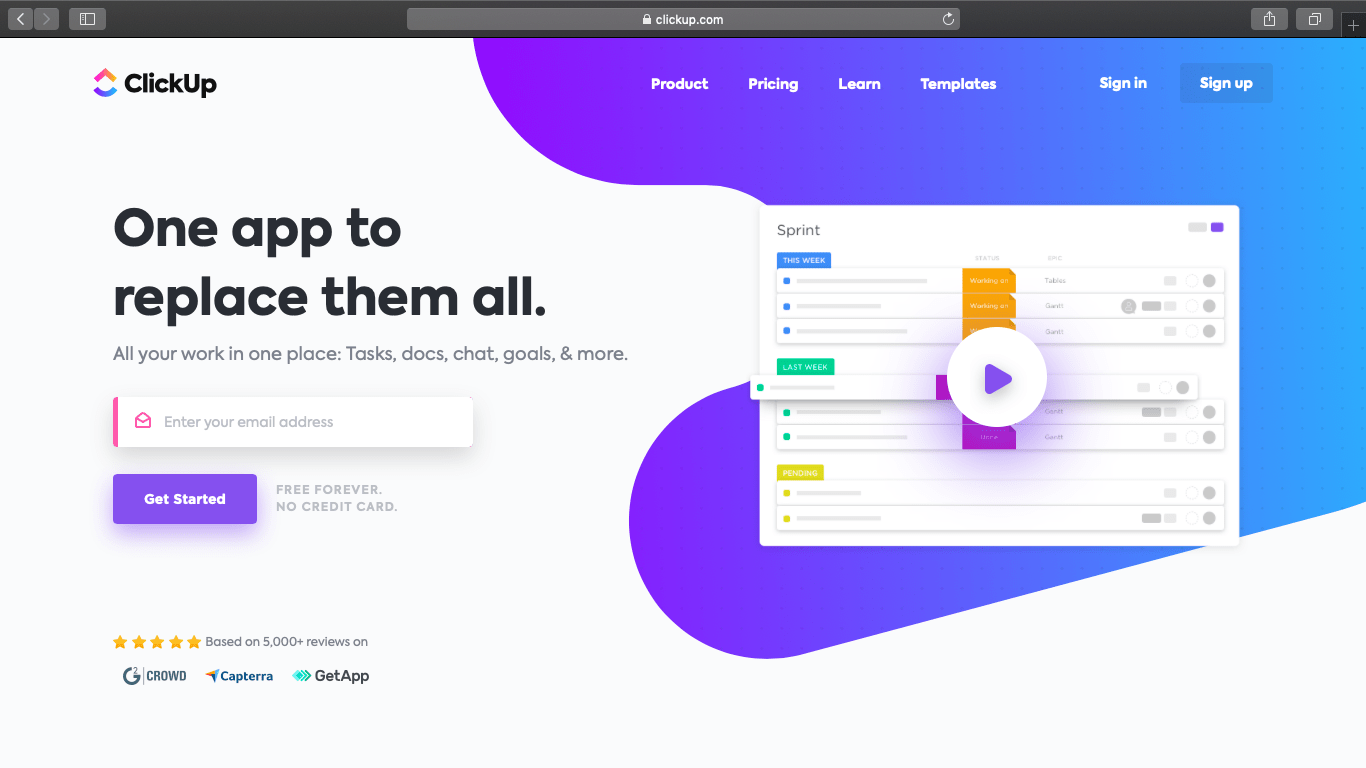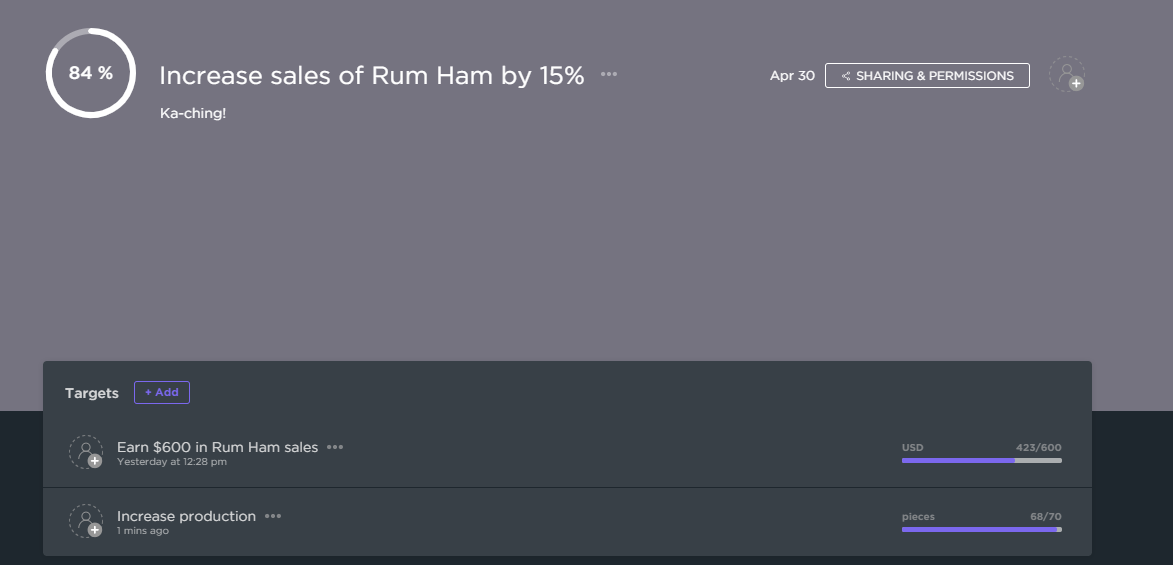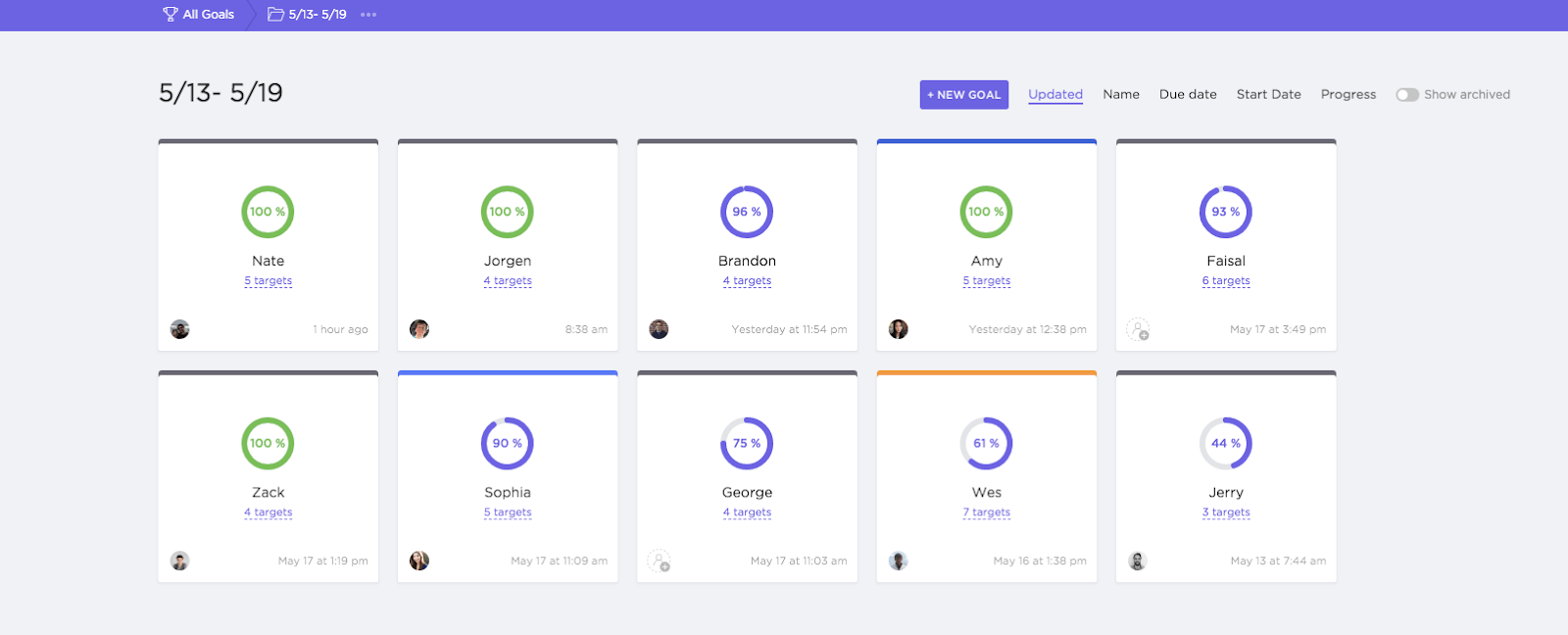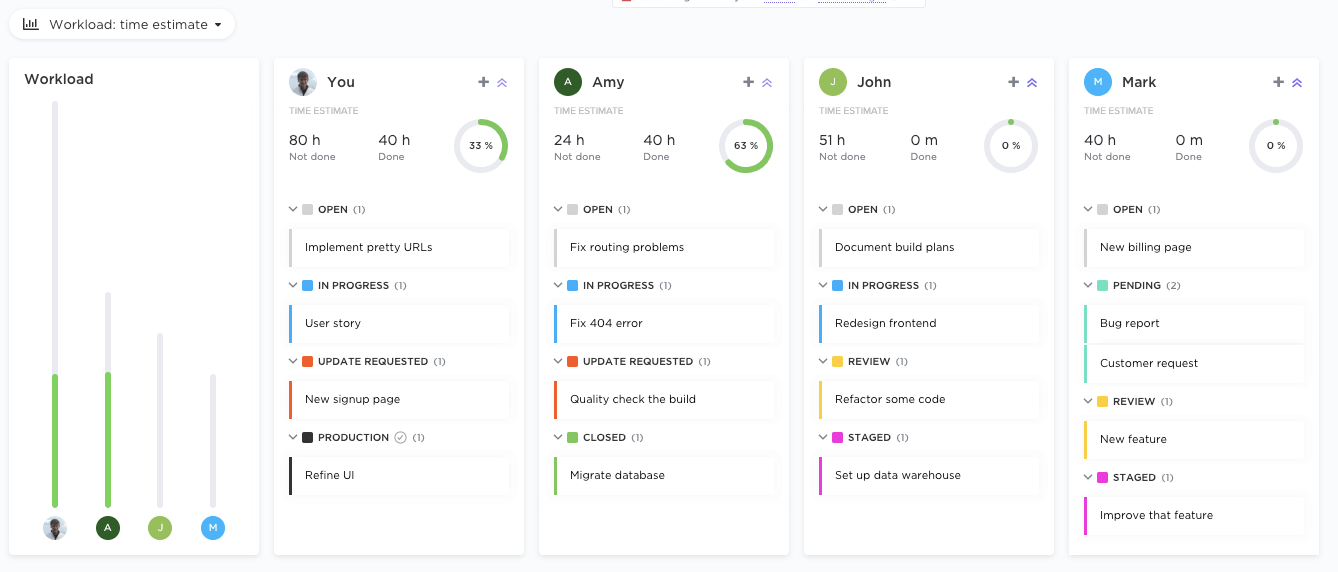

Ready to learn about the difference between goals and objectives?
Setting goals and objectives might have similar processes, but each needs to be approached differently.
In this article, we’ll help you settle the objective vs goal debate by highlighting the differences between the two, how they work together, and the best tool to help you track both!
Let’s get this started.
What Are Goals?
A goal is a desired outcome that you want to achieve.
Company goals are a compass – giving your team an idea of what they need to achieve and direction they need to go.
Basically, they’re the general intentions of the company and can help guide the mission statement. They help you zero-in on what you’re looking to achieve.
However, outcome oriented goals only deal with end-results – they don’t tell you how you’re going to get there.
That doesn’t mean goal setting isn’t important!
Goal setting is really important because it gives your team focus on what they’re aspiring towards – giving them clarity over everything, which will boost their motivation and productivity!
Bonus: SMART Goals for Students
What Are Objectives?
Objectives define what your team needs to do in order to achieve the goal.
They are specific measurable statements that have a set target for your team to reach.
In other words, they change outcome-oriented goals to process-oriented goals so there can be measurable achievements in the right direction.
For example:
Let’s say you want to amp-up the revenue of your business.
In order to do that, one of your marketing objective is to increase the number of customers by 20%.
Here, your goal is increasing revenue while your objective would be to increase customers by 20%!
Goals vs. Objectives: What Are the Major Differences?
The main difference between goals and objectives is that goals are broader in scope and help create vision and direction, while objectives are more specific targets and describe tangible actions to achieve an end result.
Here are some of these major differences between goals and objectives broken down:
1. Scope
Goals:
Goals are comparatively more general statements, so their scope can be broad.
And in some instances, they don’t even have to be limited to a team or project – broad, outcome-oriented goals can even be followed by the entire organization!
For example:
If the final goal is just to earn more money, all the members of an organization can align their efforts to accomplish this goal.
Objectives:
Project objectives are more specific than goals and usually refer to one particular process – like sales and marketing.
For example:
If we’re talking about sales and marketing objectives, then you could have process objectives like a 20% increase in the number of prospects in your sales funnel.
2. Time frame
Goals:
An organization’s goals have a longer time frame than objectives.
For example, an ideal time frame for a Fortune 500 company’s goals is around three to five years, while schools and early learning institutes prefer to use annual goals.
Objectives:
Effective objectives have a specific target that’s set around a short or medium time frame.
For example, common short term objectives can last as long as a financial quarter. Your team needs to rush to meet your objectives within this time frame.
Related: Differences between long and short term goals
Here’s a handy table to compare goals and objectives.
| Goals | Objectives | |
|---|---|---|
| Scope | Broad, general statements | Narrow, specific targets |
| Specificity | Overall desired outcome | Tangible actions |
| Measurement | Likely by quarters or years | Likely by day, week or month |
| Timeline | Long term | Short or medium term |
| Strategy | Useful for setting a direction or vision | Useful for planning steps toward an end result |
| Number | Limited goals per business category | Multiple objectives for one goal or process |
Objectives vs. Goals: How Do They Work Together?
If you have goals but no measurable objectives to support them – you won’t be able to get that sweet taste of success (and frothiness)!
Here’s how your business can use goals and objectives together to help you achieve success:
Using goals and objectives together – Step 1: Set goals
Your business goals should align with your company’s mission statement. This ensures that your goals are relevant and relatable to your customers and employees. And once you achieve this, your teams should be motivated to work together and achieve a goal together!
For example:
- A startup might be: Identify product-market fit (See how this startup uses ClickUp to track OKRs!)
- A Fortune 500 might be: Expand into the South-East Asian market
But it doesn’t end with just defining a set of goals for your business.
Once you’ve finished setting goals, you need to break them down into measurable objectives:
Using goals and objectives together – Step 2: Create SMART objectives
After the goal setting process – you need to define the objectives that can help your team achieve them.
However, there are few rules you need to follow while laying down objectives.
All you have to do is create SMART objectives!
And while yes, that does mean making your objectives more sensible, there’s more to it:
S.M.A.R.T is an acronym stands for making your objectives Specific, Measurable, Attainable, Relevant, and Timed.
You must have heard of SMART Goals, so why are we calling them SMART objectives?
It’s all about context.
We are talking about goals and objectives, and we have mentioned that objectives are what you need to do in order to attain your goals. That’s why it makes sense to talk about SMART objectives instead.
Let’s see this process in action:
1. Specific objectives
A specific objective is: Increase sales of ‘Rum Ham’ to new customers (a questionable decision, but at least it’s specific!)
2. Measurable objectives
You should also be able to track the progress of your objective and major business milestones.
Why?
How else would you verify if you’re on the right track or not?!
So while ‘increase sales of Rum ham’ is a good objective – it doesn’t have a clear-cut measure to it.
The measurable objective would be to Increase sales to new customers by 200%.
3. Attainable objectives
Your objective should also be grounded in reality.
While it would be nice to increase sales by 200%, they just don’t have enough team members to push the product.
Here, a more attainable objective is: Increase sales to new customers by 30%.
4. Relevant objectives
Smart objectives have to be important to the mission of the business. Objectives should always be linked to something that can help their business grow, improve customer satisfaction and so on.
Say you are a SaaS business. You might want to think twice about introducing done-for-you services that require human intervention. It’s unrelated to how SaaS growth models work and implies that you either lack product-market fit or a scalable growth strategy.
5. Timed objectives
Objectives can’t go on forever.
You need to create a deadline for them or you’ll keep tackling them incessantly and lose sight of your goal!
So now the final SMART objective is:
By October 2024, sales to new customers should have increased by 30%.
This way, with a smart objective, your team knows exactly what to do and how to do it.
Using goals and objectives together – Step 3: Create strategies and tactics
Once you’ve laid out the measurable targets – your team needs to figure out how they’re going to meet those objectives and achieve your ultimate goals.
This is where your target strategy comes in.
A target strategy is a series of steps or tasks that need to be done in order to accomplish the objective or target.
Remember, not every strategy you attempt will work out – it’s up to you to try different ones until you finally meet your objective.
And when you meet enough objectives, you’ll be able to meet your overall goal!
How to Keep Track of Your Goals and Objectives
Once you’ve set your business objectives and goals, your team has to work together to get the desired outcomes.
But how do you know if you’re on the right track?
When you’re on a boat in unfamiliar waters, you need a tour guide to help you figure out where you are!
A project management tool like ClickUp will help you develop and track your process oriented goals and objectives. This will help you measure past performance and keep everyone on the same page.
What’s ClickUp?

ClickUp is one of the world’s highest-rated remote project management tools. It’s used by around 200,000+ teams around the globe, including ones from startups and large corporations.
It has all the features you need to create and manage your goals and objectives with ease!
Here’s a closer look at how:
Types of Goals in ClickUp
No matter what your business is or what your business goals are, ClickUp will help you with them.
Here are some of the types of meaningful goals you can create and track in ClickUp:
- Team Goals
- Sprint Goals
- Personal Goals
- OKRs
1. Team goals
Want your team to push themselves and be more productive?
Try ClickUp’s Team Goals.
In ClickUp, Goals are high-level containers that can be broken down into smaller tangible targets.
These targets are easily measurable and, when you complete them, you’ll also complete your Goal.
This way, when using ClickUp, Targets are essentially the objectives that help you tackle your Goals!
Here’s how you can create and manage Team Goals in ClickUp.
Step 1
Click on this cute little trophy button within ClickUp.

Then simply enter your Goals into the Goal window that pops up.
For example, your team’s ultimate goal could be to increase sales by 15%:
Step 2
After you’ve set the Goal, you can assign it to your team members.

Step 3
Now that you’ve set the Goal, it’s time to create the objectives.
In ClickUp, an objective = Target
So just add your Targets that’ll help you meet your measurable goals.
And since you need to measure these targets, you can choose from a variety of units such as:
- Numbers: Any value from 0 to infinity!
- True/False: Has as a condition met or not met?
- Currency: Any amount of money
- Tasks: A task or list of tasks that has to be completed.

After you’ve set each target, you can go on to assign each one to different team members!
Step 4
Now, you can start tackling each target to meet your measurable goals and objectives.
Each time your team moves closer to one of their project goals, they can update the figures within each of their ClickUp targets.
And here comes the best part!
ClickUp automatically calculates the objective progress percentage based on the targets.
This way, whenever you or your team updates one of the targets, your overall objectives measure your progress in real-time. This can give your team members a motivational boost, so they can crush more objectives!
B. Sprint Goals
ClickUp is also the perfect tool if you’re managing an Agile software development team.
Why?
You can use ClickUp to monitor the progress of your Agile and Scrum sprints!
No, not that sprint!
A sprint is a period of time in which a software development team creates a working model of a product.
Here’s how you can track sprint goals in ClickUp:
- Create a Goal
- Set a due date for your sprint goal
- Define a set of Targets that will help you meet your sprint goal
- Add those Targets as Tasks

Now, all you have to do is continue knocking out your targets, and you can see your sprint goal’s progress percentage update in real-time!
C. Weekly Scorecards
Most goal setting tools allow you to only track your own Objectives and Goals.
However, ClickUp allows you to keep track of your team member’s individual Goals as well! In ClickUp, your team can create weekly Objectives and tasks that they need to achieve and share them with the team.

Weekly Scorecards help managers get a bird’s eye view on what everyone is working on. You also get to see how everyone is contributing towards achieving the goal.
This motivates your team to work together and accomplish more measurable goals!
But wait, Scorecards are not the only way managers can keep tabs on their team!
They can use ClickUp’s Box View and Profiles to see what tasks their team members are working on.

D. Personal goals
ClickUp isn’t just for business.
You can use ClickUp to create personal goals too!

ClickUp allows you to customize Permissions for all your goals and objectives. You can choose who can view or edit your Goals, or you can keep them completely private.
Note: You can even customize permissions for your project Goal as well. This way, you can customize what certain team members or clients can do when it comes to your Goals.
E. OKRs
Time for a pop quiz question:
What is common between Spotify, Netflix, and Amazon?
Nope – it’s not that they’re all productivity-drainers!
All 3 companies use OKRs!
Objective and key results OKRs are a goal setting framework used by organizations to set and measure goals for their company and employees. It splits each objective into a set of key results that’ll help you meet that objective.
The OKR framework may seem daunting, but it’s as easy as pie.
All you need is ClickUp.
However, in OKR terminology Objectives = Goals.
To clear up any confusion, check out this table:
| Terminology discussed so far in the article | ClickUp Terminology | OKR Terminology |
| Goals | Goals | Objectives |
| Objectives | Targets | Key Results |
- Therefore, when you’re setting ClickUp Goals, you’re setting up your OKR Objectives
- And when you’re setting up your ClickUp Targets, you’re setting up your key results

Apart from this name change, everything remains the same!
This way, if you want to follow the OKR approach, just use the steps we outlined in the Team Goals point and you’ll be fine!
Note: OKRs should not be confused with KPIs (Key Performance Indicators).
OKRs help you track your goals, while performance indicators measure the success of an ongoing process.
But we’re not done!
Scrum masters and Agile project managers get tons of handy charts to keep track of how they’re progressing towards their goals like:
- Burn up charts: highlights the project tasks your remote team has completed so far
- Burndown charts: highlights the amount of work remaining in a project
- Velocity Charts: determines your team’s task completion rate
- Cumulative flow: visualizes project’s progress over a time period
Okay, now we’re done.
Goals Vs. Objectives Conclusion
Let’s end the goal vs objective debate right here.
Goals and objectives are not interchangeable terms.
Goals are an outcome you want to achieve, and objectives help you figure out how to get there.
However, you need both of them to succeed.
Creating smart goals and objectives for your company can give your team the push that they need!
But remember when you create goals and objectives, you need a way to track them too.
And since project management tools like ClickUp have tons of features to manage your business and personal goals, why not take it for a spin and try it for free today!
Read related posts:



